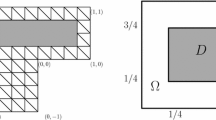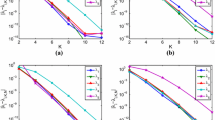Abstract
It is well known that the Ciarlet-Raviart mixed method for solving the biharmonic eigenvalue problem with Navier Boundary Condition by decomposing the operator into two Laplacians may generate spurious eigenvalues on non-convex domains. To overcome this difficulty, we adopt a recently developed mixed method, which decomposes the biharmonic equation into three Poisson equations and still recovers the original solution. Using this idea, we design an efficient biharmonic eigenvalue algorithm, which contains only Poisson solvers. With this approach, eigenfunctions can be confined in the correct space and thereby spurious modes in non-convex domains are avoided. A priori error estimates for both eigenvalues and eigenfunctions on quasi-uniform meshes are obtained; in particular, a convergence rate of \({\mathcal {O}}({h}^{2\alpha })\) (\( 0<\alpha <\pi /\omega \), \(\omega > \pi \) is the angle of the reentrant corner) is proved for the linear finite element. Surprisingly, numerical evidence demonstrates an \({\mathcal {O}}({h}^{2})\) convergent rate for the quasi-uniform mesh with the regular refinement strategy even on non-convex polygonal domains.


Similar content being viewed by others
Data Availability
All data generated or analyzed during this study are included in this article
References
Morley, L.: The triangular equilibrium element in the solution of plate bending problems. Aeronaut 19, 149–169 (1968)
Georgoulis, E.H., Houston, P.: Discontinuous Galerkin methods for the biharmonic problem. IMA J. Numer. Anal. 29(3), 573–594 (2009)
Mozolevski, I., Süli, E., Bösing, P.R.: \(hp\)-version a priori error analysis of interior penalty discontinuous Galerkin finite element approximations to the biharmonic equation. J. Sci. Comput. 30(3), 465–491 (2007)
Brenner, S.C., Monk, P., Sun, J.: \(C^0\) interior penalty Galerkin method for biharmonic eigenvalue problems. In: Spectral and High Order Methods for Partial Differential Equations—ICOSAHOM 2014. Lect. Notes Comput. Sci. Eng., vol. 106, pp. 3–15. Springer, Cham (2015)
Brenner, S.C., Sung, L.-Y.: \(C^0\) interior penalty methods for fourth order elliptic boundary value problems on polygonal domains. J. Sci. Comput. 22(23), 83–118 (2005)
Ciarlet, P.G., Raviart, P.-A.: A mixed finite element method for the biharmonic equation. In: Mathematical Aspects of Finite Elements in Partial Differential Equations (Proc. Sympos., Math. Res. Center, Univ. Wisconsin, Madison, Wis., 1974), pp. 125–145 (1974)
Gerasimov, T., Stylianou, A., Sweers, G.: Corners give problems when decoupling fourth order equations into second order systems. SIAM J. Numer. Anal. 50(3), 1604–1623 (2012)
Nazarov, S.A., Sweers, G.: A hinged plate equation and iterated Dirichlet Laplace operator on domains with concave corners. J. Differential Equations 233(1), 151–180 (2007)
Zhang, S., Zhang, Z.: Invalidity of decoupling a biharmonic equation to two Poisson equations on non-convex polygons. Int. J. Numer. Anal. Model. 5(1), 73–76 (2008)
Yang, Y., Bi, H., Zhang, Y.: The adaptive Ciarlet-Raviart mixed method for biharmonic problems with simply supported boundary condition. Appl. Math. Comput. 339, 206–219 (2018)
Li, H., Yin, P., Zhang, Z.: A \({C}^0\) finite element method for the biharmonic problem with Navier boundary conditions in a polygonal domain. Preprint at https://arxiv.org/abs/2012.12374v1 (2020)
Boffi, D.: Finite element approximation of eigenvalue problems. Acta Numer 19, 1–120 (2010)
Canuto, C.: Eigenvalue approximations by mixed methods. RAIRO Anal. Numér. 12(1), 27–50 (1978)
Grisvard, P.: Elliptic Problems in Nonsmooth Domains. Monographs and Studies in Mathematics, vol. 24, p. 410. Pitman (Advanced Publishing Program), Boston, MA (1985)
Babuška, I., Osborn, J.: Eigenvalue problems. In: Handbook of Numerical Analysis, Vol. II. Handb. Numer. Anal., II, pp. 641–787. North-Holland, Amsterdam (1991)
Chatelin, F.: Spectral Approximation of Linear Operators. Classics in Applied Mathematics, vol. 65, p. 458. Society for Industrial and Applied Mathematics (SIAM), Philadelphia, PA (2011)
Chen, L.: ifem: an innovative finite element methods package in matlab. University of Maryland, Preprint (2008)
Li, H., Yang, Y.: \(C^0{\rm IPG}\) adaptive algorithms for the biharmonic eigenvalue problem. Numer. Algorithms 78(2), 553–567 (2018)
Dörfler, W.: A convergent adaptive algorithm for Poisson’s equation. SIAM J. Numer. Anal. 33(3), 1106–1124 (1996)
Boffi, D., Durán, R.G., Gardini, F., Gastaldi, L.: A posteriori error analysis for nonconforming approximation of multiple eigenvalues. Math. Methods Appl. Sci. 40(2), 350–369 (2017)
Dai, X., Xu, J., Zhou, A.: Convergence and optimal complexity of adaptive finite element eigenvalue computations. Numer. Math. 110(3), 313–355 (2008)
Solin, P., Giani, S.: An iterative adaptive finite element method for elliptic eigenvalue problems. J. Comput. Appl. Math. 236(18), 4582–4599 (2012)
Acknowledgements
The authors would like to thanks anonymous referees for their valuable comments. This work is supported in part by the National Natural Science Foundation of China grants NSFC 11871092, 12131005, and NSAF U1930402. H. Li was partially supported by the NSF Grant DMS-1819041.
Funding
This work is supported in part by the National Natural Science Foundation of China grants NSFC 11871092, 12131005, and NSAF U1930402. H. Li was partially supported by the NSF Grant DMS-1819041.
Author information
Authors and Affiliations
Contributions
All authors contributed to the study conception and design.
Corresponding author
Ethics declarations
Conflict of interests
The authors have no relevant financial or non-financial interests to disclose.
Additional information
Publisher's Note
Springer Nature remains neutral with regard to jurisdictional claims in published maps and institutional affiliations.
Rights and permissions
About this article
Cite this article
Zhang, B., Li, H. & Zhang, Z. Solving Biharmonic Eigenvalue Problem With Navier Boundary Condition Via Poisson Solvers On Non-Convex Domains. J Sci Comput 92, 24 (2022). https://doi.org/10.1007/s10915-022-01878-9
Received:
Revised:
Accepted:
Published:
DOI: https://doi.org/10.1007/s10915-022-01878-9




